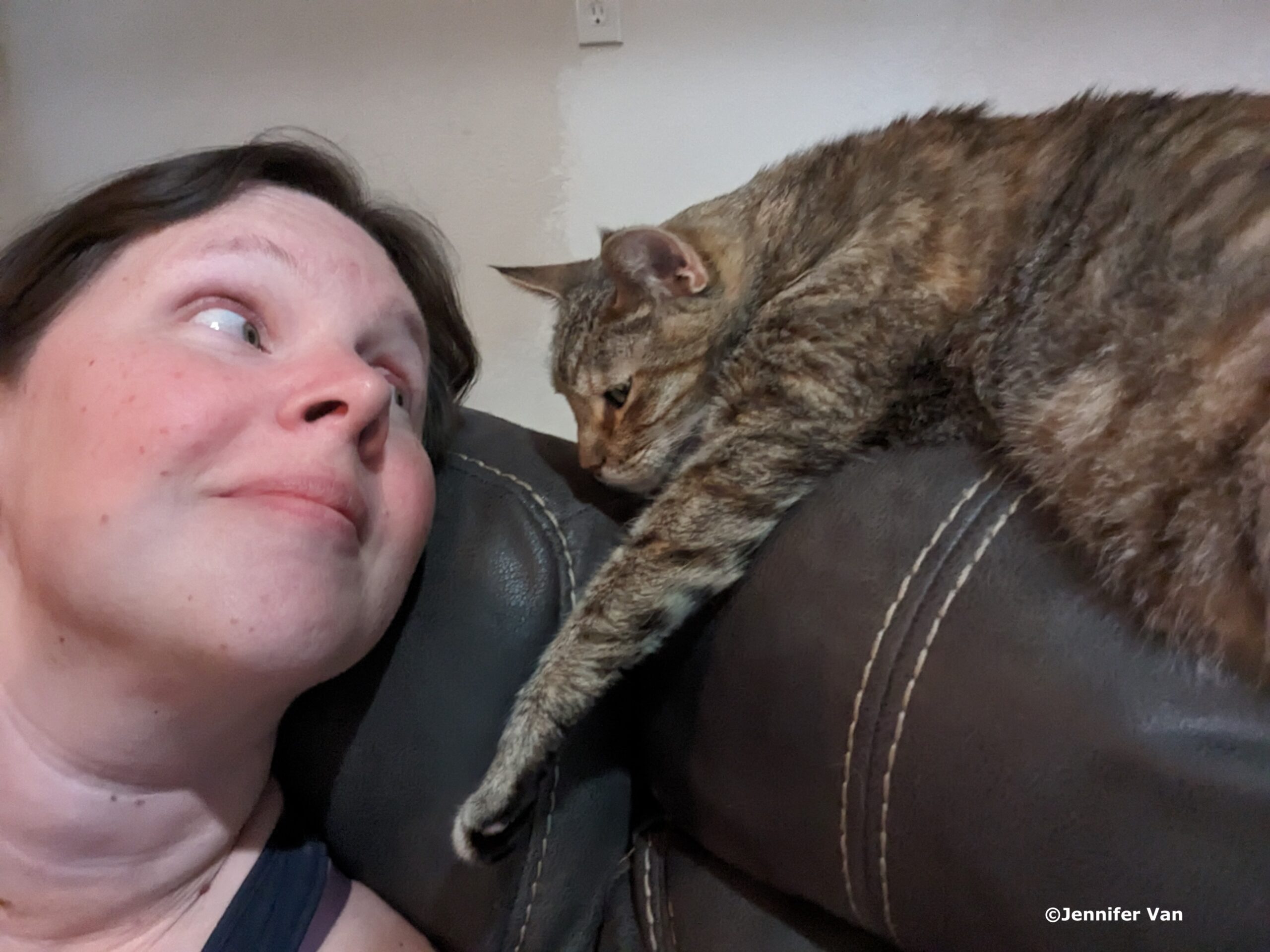Barks Blog
Cooperative Care with Cora: A Case Study

by Jennifer Van Valkenburg
Cooperative care is a topic that is near and dear to my heart. I have come to appreciate how important body autonomy and choice can be, especially when experiencing a painful and difficult medical diagnosis. Having some control over even small things can make a huge difference in our emotional state and comfort level. The same is true of our pets. The more they can participate in their own healthcare, the better for everyone involved.
I started down the road of learning about cooperative care when my own cat, Cora, was diagnosed with an incurable medical illness and required continual care. I saw how quickly she changed from a happy-go-lucky free spirit to a frightened, antisocial creature over the course of only a few vet visits. I wanted her to be healthy, but not at the expense of her mental health, so I set out to find better ways to provide her medical care while also helping her feel safe and giving her some amount of control.
We adopted Cora at 6 months old in the winter of 2017. She was absolutely adorable and filled with excited energy. She was raring to get out of the shelter and learn everything she could about the world. We were happy to have her in our house, and eventually she was introduced to our other cat, Chex. Everything was going well until one day, Cora started refusing to eat. She declined rapidly. She became listless and apathetic and started hiding under the bed covers. A few urgent vet visits later, she was diagnosed with stomatitis.
Stomatitis is inflammation of the oral cavity usually leading to pain and hypersensitivity. The cat’s immune system overreacts to plaque or tartar, which causes significant inflammation and pain in their mouth. According to VCA Animal Hospitals’ website, “The treatment of stomatitis involves treating the underlying cause of the problem if there is one that can be identified. Most often no specific cause is determined. Many cats will require broad-spectrum antibiotics, chlorhexidine rinses or gels, and anti-inflammatory medications” (Hiscox & Bellows, n.d.).
Cora had good days and bad days. Sometimes she was in so much pain she would not eat, causing her to rapidly lose weight and become weak and dejected. She was often treated with antibiotics and steroid injections, and she received multiple infusions to keep her hydrated and to get nutrients into her body.
Every month or two she received injections at the vet clinic, and I also constantly administered oral liquid antibiotics and pain medication. Part of what made administering her oral medications so difficult was that the area of her body that was inflamed and in pain was her gums and throat. She started fighting me every step of the way. I would towel wrap her, lock us both in the bathroom, and struggle through giving her medication, all the while feeling guilty and sure that there was a better way.
I started digging around to find classes, webinars, and other educational materials about cooperative care in general, and with cats specifically. Among them, two in particular stood out. One was ZooSpensefull’s online conference on cooperative care, focused on animals of all species and sizes from wildlife rescues to zoos across the globe. Another was Caroline Crevier-Chabot’s comprehensive directory of cooperative care videos. Cora and Chex were already clicker trained—they knew how to target and had station spots to go to when needed as well. Since that training had been fun for all of us, I thought cooperative care training would be the way to start working on making Cora’s medical experiences better. I picked up my clicker and got to work.
The first thing I focused on was creating a more positive experience for Cora when she was in her carrier. I lined the carrier with blankets from her sleeping spots around the house so it would smell like her. I put some treats in the way back of the carrier, opened the top and front doors, and made a line of treats leading out. I then took out my target clicker and slowly, using the target, moved Cora closer and closer to the carrier over a number of sessions. I watched her for signs of stress or fear and always went at her speed and her pace. She very quickly became comfortable going in and out of the carrier on her own to get treats, but was not interested in staying inside the carrier for any amount of time.
I then took her towel, which is her station, and placed it next to the carrier, and we worked on station training beside the carrier for a few sessions. She didn’t seem anxious or concerned being next to the carrier on her station, so I moved the towel so a little bit of it was inside the carrier with the door open and then asked her to station. It took some time and many sessions of stationing and moving the towel closer to and farther inside the carrier to get her comfortable enough to put her head inside the carrier. Once she did, I could consistently get her to walk inside the carrier, stay on her station, and then walk back out with the promise of lots of treats and head rubs.
Unfortunately, we had a setback with the carrier training after one of Cora’s vet visits. She needed to have a tooth extraction. She awoke and recovered very slowly from the sedation at home. Her face and jaw were swollen, and she was in a lot of pain. She was receiving pain medication and antibiotics, but found the whole experience so traumatizing that she refused to go near her carrier again. I decided to buy her a new carrier and start carrier training over from scratch with the new one in the hopes that it would provide a clean slate with no negative associations.
While working on Cora’s carrier training, I also worked on desensitizing her to being touched around her mouth and throat so that I could give her medication while causing her less stress. She greatly enjoys being petted on the top of her head and stroked under her chin, but she does not like being held or her mouth being opened or pressure put on her gums or teeth. Most of her medications are administered via a syringe filled with liquid, so I’ve been practicing this handling using the same syringe filled with water. I dip the end of the water syringe in some wet food or tuna water and let her lick that off the syringe. She will lick liquid treats from the syringe; however, she won’t lick the medicine due to both the smell and that she’s usually feeling poorly and not interested in eating. I have an extra bottle of her prescribed antibiotics (from a time I was given them over a holiday break in case they were needed) that I’ve been using to desensitize her to the smell. I dip the tip of the syringe in the antibiotic and then fill a separate syringe with her favorite liquid treat. I then alternate the syringes. She smells the antibiotic and then licks the treat from the other syringe. I’ve had some success with this method because she comes to me excited now when the syringes come out. Luckily, since she’s been feeling well, I haven’t had the opportunity to try this when she’s feeling ill. My goal is for her to eventually drink the liquid directly from the syringe so I will not need to hold her head or mouth at all when administering the medication.

I’m also always looking for ways to involve Cora directly in her care and allow her to make choices. To give Cora her medicine, I hold her head and squeeze the medicine into the side of her mouth. She is free to walk away at any time, and we resume again after a few minutes once she has calmed down. I let her choose which treats she wants after receiving medicine, and I hold my hand out and allow her to come over to be petted rather than going to her. After making these small changes, I have seen her exhibit more willingness to come over to me and fewer signs of stress. She seems to feel more in control of what is happening to her and knows she can walk away at any time, making getting her medication less scary.
I continue to work on getting Cora more comfortable with the tools involved in her care, including the liquid syringe and the smell of her medicine. It’s a slow road filled with speed bumps since whenever she takes a downturn, it sometimes feels like starting over from scratch.
She will need this level of care for the rest of her life, so I am hopeful that with continued training she will adjust and feel more comfortable as time goes on. As important as it is to keep her body healthy, it’s equally important that Cora feels safe and comfortable in her environment. I continually strive to support and maintain both her mental health and physical health. Hopefully, someday we will reach our goals together.
Reference
Hiscox, L., & Bellows, J. (n.d.). Gingivitis and stomatitis in cats. VCA Animal Hospitals. https://vcahospitals.com/know-your-pet/gingivitis-and-stomatitis-in-cats
Recommended Resources
Crevier-Chabot, C. Cat Training and Handling Videos. https://cattrainingandhandlingvideos.com/
ZooSpensefull. Cooperative Care Conference and Workshop [webinar]. https://zoospensefull.com/product-category/webinar/


